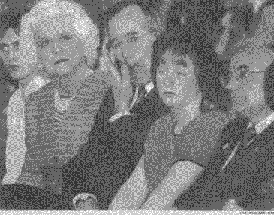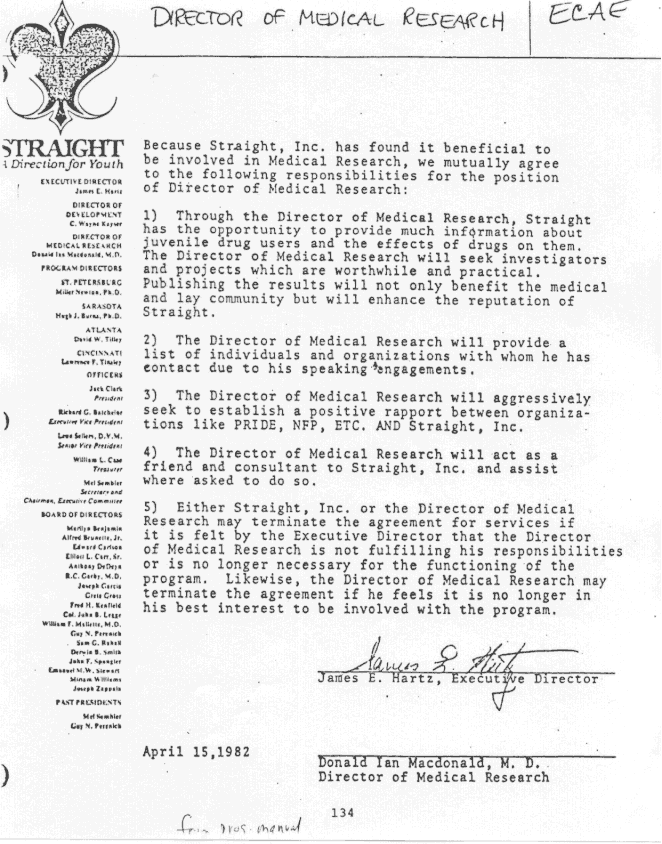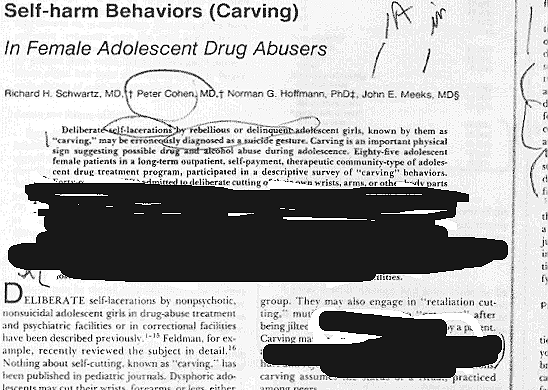Five notable problems which led to its abrupt demise occurred between 1974 and 1975 with the always controversial Seed program.
- First Florida state health regulators instituted a set of regulations to administer the host home element of The Seed. Art Barker, The Seed’s founder, had declared that the new regulations undermined the effectiveness of his program and he refused to abide by them.
- Second, the U.S. House of representatives had conducted a study of The Seed and concluded that Barker had refused to let government auditor’s see where federal grant money was being spent. That is, he refused to open his books to federal auditors.
- Third, the U.S. Senate had conducted a study of The Seed and had determined that the methods used by The Seed were experimental. The Senate found that NIDA’s own regulations require that human subjects participating in U.S. government sponsored research projects be required to sign consent forms. Thus the Senate had directed Robert DuPont (the head of NIDA) to require that Art Barker get consent forms from both parents and children who were being subjected to experimental and potentially harmful treatment.
- Fourth, the Senate determined that under its federally mandated charter LEAA had not been established by Congress to sponsor medical research and thus the Senate directed that LEAA cease all funding for research projects like The Seed. In February 1974, in direct response to pressure from Senator Ervin who headed the Senate’s investigation of LEAA, Don Santarelli, head of the LEAA, held a press conference to announce the cancellation of all LEAA funding for medical research, psychosurgery, and behavior modification programs because, in his words, there "are no technical skills on the staff to screen, evaluate, or monitor such projects."
- Fifth, and most damning of all, was the finding by the U.S. Senate which likened The Seed’s approach to juvenile drug rehabilitation to the methods employed by North Korean Communist to attempt to "brainwash" American prisoners-of-war during the Korean War.
It was six months after the founding Seed lost its license that Melvin and Betty Sembler and some other former Saint Petersburg Seed parents formed Straight, Inc. It was Melvin Sembler who would inherit the host home regulations that had been drafted to regulate The Seed. And for sixteen years Straights would pop open all over the country, locking kids in bedrooms and nailing windows shut, forcing them to urinate in jars in those over-crowed bedrooms, refusing them the right to read even a Bible in those host homes--battling state health officials from Florida to California as if each cited violation was the first time they had ever heard kids should not be treated that way.
Straight had been incorporated back in April 1976. The board waited till late July to announce plans for an imminent opening of the flagship facility. At that time board member Leon Sellers stated that Straight hoped to avoid government financing. But just two weeks later Jim Hartz, Straight’s executive director, announced that Straight had accepted a $47,394 grant from LEAA to be administered through the Pinellas Metropolitan Criminal Justice Planning Council. The city of St. Petersburg would be Straight’s sponsor. The Council was responsible to the state’s Bureau of Criminal Justice Planning and Assistance (BOCJPA) in Tallahassee. In spite of the Senate’s directive to LEAA to stay out of the medical experimentation/medical treatment business LEAA was back at it as early as July 1976, and gave Straight another $50,000 grant in 1977. But since LEAA was not chartered to sponsor medical research in the first place, it did not require any silly "human consent forms" for medical research, so Sembler was able to dodge that bullet.
Now if you think that medical doctors are too savy
to join a cult, just look at The People’s Temple. Remember it was a licensed
medical doctor who fed the children Kool Aid laced with cyanide. Of course
as the children wreathed in agony on the ground, Reverend Jim Jones himself
had one of his parishioners simply shoot him in the back of the head. Or
look at our own Synanon Church. It was licensed medical doctors who performed
around-the-clock mass sterilizations on all Synanite males ages 18 and
above (except, of course, for Reverend Chuch Dederich who was exempt).
Like attorneys and politicians, medical doctors are special recruitment
targets for Straight. Especially pediatricians. Consider, for example a
Clearwater, Florida pediatrician named Don Ian Macdonald. In 1979 he sent
his 15 year-old son Andy across the bay to Straight in Saint Petersburg.
Dr. Macdonald went on to head Straight’s medical research program. But
before we discuss him you have to understand his teacher–Dr. George Ross.
And before you can understand Dr. Ross you have to know about Helen Petermann.
 |
| Vice President George Bush shedding a tear at a Straight-St Pete Open Meeting in March 1987. On his right is Florida Congressman Michael Bilirakis. |
| Drug Czar Carlton Turner, Macdonald's predecessor, embraces the front page of Miller Newton's book NOT MY KID: A Parent's Guide to Kids and Drugs with these words: Not MY KID should be required reading for any parent concerned about their children's future. |
You recall that Macdonald, a Clearwater pediatrician, who placed his 15 year-old son, Andy, in Straight-Saint Pete? When Dr. Macdonald placed his boy in Straight in 1979, after learning that Andy’s "drug of choice was marijuana", he became a natural target for Straight. Not only was he a pediatrician with a kid in trouble but his wife Bobbie was active in Pinellas County Republican politics and even served on the Indian Rocks Beach City Commission. In 1988 she told a reporter for the Lexington Herald-Leader that Andy owed his life to Straight and added, "and he knows it." When Macdonald wrote an article on drug abuse for NIDA in 1981, he referenced Miller Newton. In 1982 Macdonald served with Robert DuPont on NIDA’s Workgroup on Marijuana Abuse in Adolescence. [Robert DuPont had been the founding director of NIDA, the second White House Drug Czar and a paid Straight consultant.]
In 1982 Dr. Macdonald became Straight’s National Research Director. In 1984 he authored the book Adolescent Drug and Alcohol Abuse which pushed five juvenile drug rehab program models. One of those programs was Straight, Inc. On page 16 he shows those four silly diagrams of druggie mood swings that he got from Miller Newton–the same charts that all Straight parents get bombarded with when they go through the "Six New Parent Raps" produced by Dr. Newton. In 1984 he became director of the Alcohol, Drug Abuse and Mental Health Administration. In 1985 he was appointed acting assistant secretary of the Health and Human Services Department. And in 1987 Dr. Donald Ian Macdonald, M.D. became The White House Drug Czar for Ronald Reagan.
While in Washington Dr. Macdonald's daughter Sally worked for Florida Republican Congressman Michael Bilirakis shown with George Bush above at a Straight Open Meeting. [Saint Petersburg Times, Jan 17, 1989, Section: National, p. 1A,] It was during his time as the White House Drug Czar that he invited his old mentor Dr. George Ross over to the White House and admitted to a reporter that he knew "almost nothing" about drug addiction before meeting George Ross. [LEXINGTON HERALD-LEADER, March 2, 1988, page B1, SECTION: CITY/STATE ]


